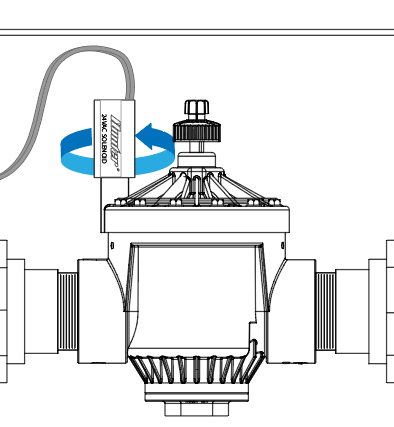The most common reason for a valve to remain on, or weep, is debris. New installations without proper flushing, recent mainline repair, or well water can cause debris to flow into the valve and get caught between the diaphragm and the seat.

It's also possible that there is debris in the valve, which is causing the diaphragm of the valve to remain open.
- SHUT OFF the main water supply. Opening a valve under pressure is dangerous and you could be injured.
- Unscrew the solenoid by turning counter-clockwise (cylinder with two wires) and make sure the plunger is clean and moves freely. You can test the solenoid by running that station manually from the controller and see if the plunger retracts when energized.
- Unscrew the BONNET SCREWS or jar top depending on your valve model. Be careful when you pull the bonnet away from the body as to not lose the diaphragm or spring.
- The diaphragm (9) may be sitting in the body or captured in the bonnet (7). Remove the DIAPHRAGM (9) and SPRING (8). Make note of the orientation of the diaphragm so you can put it back together, the same way it came out.
- Examine the diaphragm and spring. The diaphragm should be clean and free of wrinkles, tears, or perforations. The seal should be clean and free of nicks, dents or abrasions. Wash the diaphragm with clean fresh water to remove any debris that may have been deposited there.
- The diaphragm spring should be intact and bounce back when compressed.
- Examine the valve body and remove any debris, pebbles, or dirty water.
- The seal seat (10) should be clean and free of nicks, grooves, or abrasions as well.
Issue: A tear in the internal part called the diaphragm would cause the valve not to close.
Solution: Dissaasemble the valve and inspect the internal parts.


It's possible your valves have been opened manually. You'll need to locate your valve box(s) and turn the solenoid(s) clockwise until snug. The solenoid is located on the top of the valve and looks like a cylinder with two wires protruding out of it.
Hunter valves require at least 20 PSI to close.
Operating Specifications
- Recommended pressure range: 20 to 150 PSI
- Temperature rating: 150°F
Solenoid Specifications
-
24 VAC solenoid
- 350 mA inrush, 190 mA holding, 60 Hz
- 370 mA inrush, 210 mA holding, 50 Hz
Issue: The bleed screw on the top of the valve might be loose or open.
Solution: Handtighten the bleed screw.

Issue: The valve is installed backward, which would be the opposite of the necessary flow direction.
Solution: Reinstall the valve. The arrow on the valve should be directed toward the sprinkler heads in the correct flow direction.

Still need help? We're here.
Tell us what you need support with and we'll find the best solution for you.

